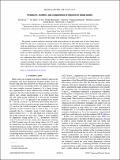| dc.contributor.author | Ge, Li | |
| dc.contributor.author | Pick, Adi | |
| dc.contributor.author | Burkhardt, Stephan | |
| dc.contributor.author | Liertzer, Matthias | |
| dc.contributor.author | Rotter, Stefan | |
| dc.contributor.author | Liu, David | |
| dc.contributor.author | Zhen, Bo | |
| dc.contributor.author | Hernandez, Felipe | |
| dc.contributor.author | Johnson, Steven G | |
| dc.date.accessioned | 2017-03-17T20:33:42Z | |
| dc.date.available | 2017-03-17T20:33:42Z | |
| dc.date.issued | 2017-02 | |
| dc.date.submitted | 2016-11 | |
| dc.identifier.issn | 1050-2947 | |
| dc.identifier.issn | 1094-1622 | |
| dc.identifier.uri | http://hdl.handle.net/1721.1/107481 | |
| dc.description.abstract | We present a general method to obtain the stable lasing solutions for the steady-state ab initio lasing theory (SALT) for the case of a degenerate symmetric laser in two dimensions (2D). We find that under most regimes (with one pathological exception), the stable solutions are clockwise and counterclockwise circulating modes, generalizing previously known results of ring lasers to all 2D rotational symmetry groups. Our method uses a combination of semianalytical solutions close to lasing threshold and numerical solvers to track the lasing modes far above threshold. Near threshold, we find closed-form expressions for both circulating modes and other types of lasing solutions as well as for their linearized Maxwell-Bloch eigenvalues, providing a simple way to determine their stability without having to do a full nonlinear numerical calculation. Above threshold, we show that a key feature of the circulating mode is its “chiral” intensity pattern, which arises from spontaneous symmetry breaking of mirror symmetry, and whose symmetry group requires that the degeneracy persists even when nonlinear effects become important. Finally, we introduce a numerical technique to solve the degenerate SALT equations far above threshold even when spatial discretization artificially breaks the degeneracy. | en_US |
| dc.description.sponsorship | United States. Army Research Office. Institute for Soldier Nanotechnologies (Grant W911NF-07-D-0004) | en_US |
| dc.description.sponsorship | Austrian Science Fund (Project SFB NextLite F49-P10) | en_US |
| dc.description.sponsorship | United States. Air Force Research Laboratory (Agreement FA8650-15-2-5220) | en_US |
| dc.publisher | American Physical Society | en_US |
| dc.relation.isversionof | http://dx.doi.org/10.1103/PhysRevA.95.023835 | en_US |
| dc.rights | Article is made available in accordance with the publisher's policy and may be subject to US copyright law. Please refer to the publisher's site for terms of use. | en_US |
| dc.source | American Physical Society | en_US |
| dc.title | Symmetry, stability, and computation of degenerate lasing modes | en_US |
| dc.type | Article | en_US |
| dc.identifier.citation | Liu, David et al. “Symmetry, Stability, and Computation of Degenerate Lasing Modes.” Physical Review A 95.2 (2017): n. pag. © 2017 American Physical Society | en_US |
| dc.contributor.department | Massachusetts Institute of Technology. Department of Mathematics | en_US |
| dc.contributor.department | Massachusetts Institute of Technology. Department of Physics | en_US |
| dc.contributor.department | Massachusetts Institute of Technology. Research Laboratory of Electronics | en_US |
| dc.contributor.mitauthor | Liu, David | |
| dc.contributor.mitauthor | Zhen, Bo | |
| dc.contributor.mitauthor | Hernandez, Felipe | |
| dc.contributor.mitauthor | Johnson, Steven G | |
| dc.relation.journal | Physical Review A | en_US |
| dc.eprint.version | Final published version | en_US |
| dc.type.uri | http://purl.org/eprint/type/JournalArticle | en_US |
| eprint.status | http://purl.org/eprint/status/PeerReviewed | en_US |
| dc.date.updated | 2017-02-23T23:00:05Z | |
| dc.language.rfc3066 | en | |
| dc.rights.holder | American Physical Society | |
| dspace.orderedauthors | Liu, David; Zhen, Bo; Ge, Li; Hernandez, Felipe; Pick, Adi; Burkhardt, Stephan; Liertzer, Matthias; Rotter, Stefan; Johnson, Steven G. | en_US |
| dspace.embargo.terms | N | en_US |
| dc.identifier.orcid | https://orcid.org/0000-0002-2312-8483 | |
| dc.identifier.orcid | https://orcid.org/0000-0002-7572-4594 | |
| dc.identifier.orcid | https://orcid.org/0000-0001-7327-4967 | |
| mit.license | PUBLISHER_POLICY | en_US |
